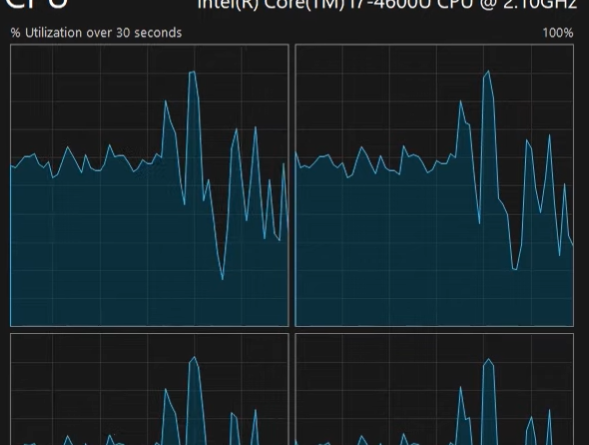You can check CPU usage and bottlenecks through tools like MSI Afterburner, HWMonitor, or Task Manager (Ctrl + Shift + Esc). If CPU usage is at 100% while the GPU is underutilized, you’re experiencing a CPU bottleneck.
3. Causes of CPU Bottleneck
Several factors contribute to CPU bottlenecking:
- Weak CPU Paired with a Powerful GPU: When a low-end or older CPU is paired with a high-end GPU, the CPU cannot process the data fast enough to keep up with the GPU. We went over this above.
- High-Refresh-Rate Gaming: In games with high frame rates (e.g., 144 Hz or 240 Hz), the CPU needs to process more frames per second, which can overwhelm weaker processors.
- CPU-Intensive Tasks: Applications that rely heavily on the CPU for things like physics, AI, or open-world calculations can overload the processor even without the GPU being used.
- Multitasking: Running multiple programs or browser tabs in the background can also max out CPU usage, leading to insufficient CPU “resources” for your heavy tasks.
4. How to Fix or Minimize CPU Bottleneck

A. Overclock Your CPU
Overclocking the CPU can provide a temporary performance boost, allowing it to process more tasks per second and reduce bottlenecks. Most modern CPUs, like Intel’s K-series processors or AMD’s Ryzen series, support overclocking.
- Use tools like Intel XTU or AMD Ryzen Master to safely overclock your CPU and improve performance.

B. Overclock RAM

- Access BIOS, then navigate to navigate to the overclocking or memory settings section. Enable XMP to automatically apply a higher frequency profile for your RAM.
- Manually Adjust RAM Frequency (Optional for further tuning): Go to the DRAM frequency settings and set it to a higher value than the default (e.g., from 2400 MHz to 3200 MHz). Adjust the voltage slightly if needed (typically between 1.35V – 1.4V).
- Adjust Timing (Optional for Advanced Users): Fine-tune CAS latency and other memory timings for more optimization.Test Stability: Run stress tests like MemTest86 or use benchmarks to ensure stability
C. Lower Graphics Settings

- Lower Draw Distance: Reducing the distance at which objects are rendered in open-world games can significantly reduce CPU strain.
- Disable or Lower Physics and AI Settings: Features like real-time physics or advanced AI often consume a lot of CPU resources. Turning them down can free up the CPU.
- Turn Off Background Tasks: Disable CPU-heavy processes like background downloads, streaming, or system scans when gaming.
D. Lower Resolution
If despite these changes, the CPU bottleneck is still severe, then you have no choice but to use another laptop or upgrading the CPU if you have a desktop.
Now, it’s important to keep BALANCE in mind. CPU or GPU bottlenecks often occur because there is an imbalance of power: A CPU too WEAK for a GPU that’s too powerful.
If you’re building or upgrading a PC, aim for a balanced system where the CPU and GPU complement each other. Pairing a low-end CPU with a high-end GPU or vice versa will lead to bottlenecking.
A mid-range GPU like the RTX 3060 pairs well with a Ryzen 5 or Core i5, while high-end GPUs like the RTX 4090 are better suited to Ryzen 9 or Core i9 CPUs
Are CPU Bottlenecks BAD?
Like a GPU bottleneck, a slight CPU bottleneck is not necessarily bad, especially in gaming. Many games are GPU-bound, meaning they rely more on the graphics card than the CPU.
However, if the CPU bottleneck becomes severe then it must be addressed PURELY because you are not satisfied with the performance. This isn’t as harmful as thermal throttling…it just means the CPU is being fully used and as long as temperatures are low while doing so there is no harm to the CPU.
 wowDecember 18, 20255 Best Laptops For World of Warcraft – Midnight & Classic (2026)
wowDecember 18, 20255 Best Laptops For World of Warcraft – Midnight & Classic (2026) LaptopsDecember 17, 2025The 4 Best Laptops For Virtualization of 2026 (10-50 VMs ATSM)
LaptopsDecember 17, 2025The 4 Best Laptops For Virtualization of 2026 (10-50 VMs ATSM) Hardware GuideDecember 17, 20252026 Beginner Guide to Reading Computer (Laptop) Specifications
Hardware GuideDecember 17, 20252026 Beginner Guide to Reading Computer (Laptop) Specifications LaptopsJune 30, 2025Best Laptops for Computer Science (July 2025 )
LaptopsJune 30, 2025Best Laptops for Computer Science (July 2025 )






